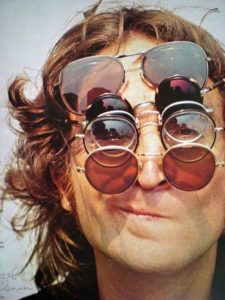Did John Lennon have Irlen Syndrome?
John Lennon’s beautiful music with the Beatles may not have existed without his perseverance through many challenges in his life, including dyslexia. Lennon excelled at art and music while attending high school, but his grades were poor and he had trouble spelling. He was rowdy in the classroom and was called a troublemaker.
John can be seen wearing the 14 carat gold spectacles, which use an early version of photo chromatic glass (a lens that reacts to light and dark surroundings), in the documentary ‘Imagine: John Lennon‘ whilst sitting at his Steinway in the sound studio.
John Lennon was very nearsighted and was embarrassed to wear glasses until much later in his career, when the iconic pair of round glasses became his signature look. John was one of the first, along with Buddy Holly, to use his glasses as a fashion statement. John first started to wear his ‘granny’ style glasses in September 1966, when he received a pair in preparation for his role in Richard Lester’s film “How I Won The War”.
During his sister’s more recent visit to St Paul’s Eye Unit in Great Britain, John’s glasses were passed through a machine that takes a measurement of the prescription called a focimeter, to see just how nearsighted he was. The test revealed that aged 31, John was severely myopic, and had astigmatism. His lenses read -8.25 from his right eye, and -7.50 from his left.
“Without his glasses the world would have been blurred and distorted for John. He would have been able to see the end of the guitar and the frets, but anything else beyond that would have been difficult for him,” said Professor Simon Harding, a consultant at St Paul’s Eye Unit. “His short sightedness was at a level such that it’s likely it would have worsened later in life and may have become a threat to his vision.” We know that often the worse acuity, especially in people with learning challenges, can be worsened by sensory stress over time and light sensitivity can be a major factor contributing to stress. This condition known as scotopic sensitivity, photophobia, or Irlen Syndrome, was identified in the 1980s by researcher and learning specialist, Helen Irlen, in California, when working with adults with reading problems in a community college. She found that fluorescent lighting found in most classrooms and work environments contributed to symptoms of dyslexia and dyscalculia and attention/focus problems which impacted academic success and function.
Poor vision seemed to run in Lennon’s family, as his sister Julia explained: “I’m thrilled to be involved in View from the Stars, which helps children and adults with vision problems. John, our mother and I all wore glasses because we were all very nearsighted. It wasn’t cool to wear glasses when The Beatles played the Cavern, and when The Beatles became famous John wore contact lenses.
“However, that later changed and the style of John’s glasses is one that is still instantly recognizable today.
“It was fascinating to be given lenses that replicated what John would have seen without his glasses, and it wasn’t much at all.” Said Julia.
His troubles in school, especially with spelling and memorization suggest that he likely had dyslexia, and at least one biographer (Albert Goldman) believed he was dyslexic, though Lennon was never formally assessed. Whatever barriers dyslexia put in his way, his determination, creativity and supportive family overcame.
This artwork created by artist and vitrographer, Jean Pierre Weil, shows Lennon in his iconic look with tinted lenses. He may have had Irlen syndrome and figured out that the tints helped decrease visual stress which contributed to his visual stress, reading and attention problems, depression, and possibly improved his vision as well. We will never know for sure since inventor Helen Irlen, did not begin providing Irlen Syndrome testing and Irlen Spectral Filters until the 1980s. Lennon died in 1980. His glasses are part of the memorabilia kept for posterity by his family.


